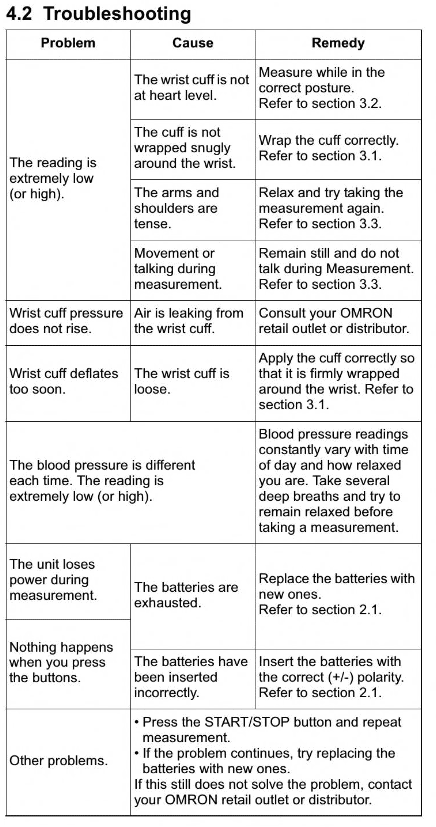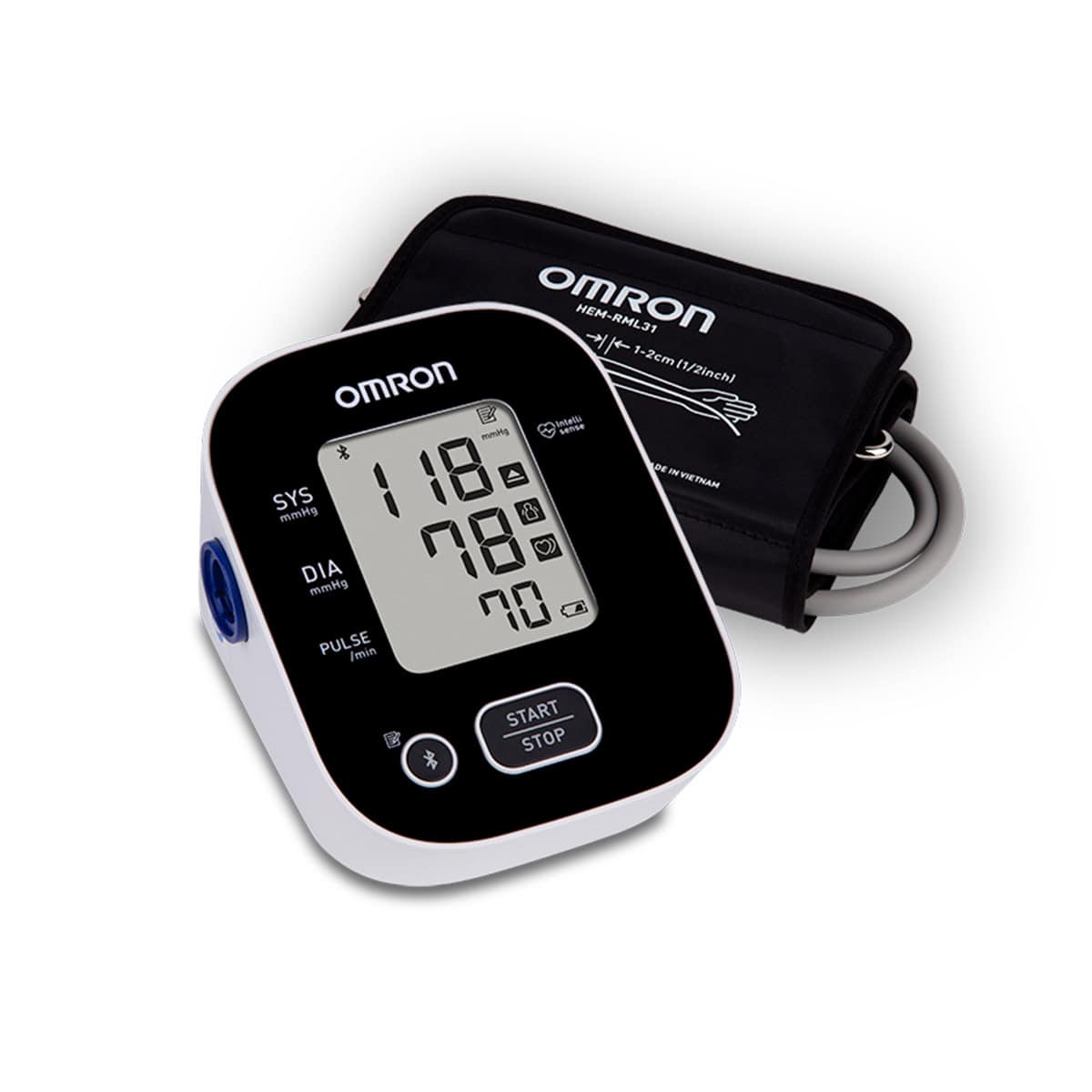Omron blood pressure monitors are popular tools for tracking cardiovascular health at home. These devices use symbols to convey important information about your readings and the monitor’s status. Understanding these symbols is key to getting accurate results and troubleshooting any issues that may arise.
Omron monitors display an irregular heartbeat symbol when they detect a rhythm that is 25% less or 25% more than the average during measurement. This irregular heartbeat detection helps alert you to potential heart rhythm abnormalities that may require medical attention. Other common symbols include battery indicators, movement error warnings, and cuff fit indicators.
Proper use of your Omron monitor ensures reliable readings that can help you and your doctor manage your blood pressure effectively. The American Heart Association recommends home monitoring for people with high blood pressure, making it crucial to understand your device’s symbols and functions.

| Symbol | Meaning |
|---|---|
| ♥ | Irregular heartbeat |
| 🔋 | Low battery |
| ⚠️ | Movement error |
| 👕 | Cuff fit indicator |

Understanding Your Omron Blood Pressure Monitor: Symbols and Troubleshooting
Omron blood pressure monitors are popular for their ease of use and accuracy in tracking heart health. However, you might occasionally encounter symbols or error messages that can be confusing. This guide will help you understand common Omron blood pressure monitor symbols and troubleshoot potential issues.
Common Symbols
- Heart Symbol: This indicates an irregular heartbeat has been detected.
- Movement Symbol: This appears if you move too much during the measurement, which can affect accuracy.
- Cuff Symbol: This may indicate the cuff is not wrapped correctly or is too loose.
- Error Symbols (E1, E2, etc.): These indicate specific errors. Refer to your user manual for the meaning of each error code.
Troubleshooting Tips

- Cuff Placement: Ensure the cuff is placed correctly on your upper arm, about 1 inch above the elbow.
- Cuff Fit: The cuff should be snug but not too tight. You should be able to fit two fingers between the cuff and your arm.
- Body Position: Sit upright with your back straight and feet flat on the floor. Rest your arm on a table at heart level.
- Remain Still: Avoid talking or moving during the measurement.
- Batteries: Make sure the batteries are inserted correctly and have enough power.
- Cuff Connection: Check that the air tube is properly connected to both the cuff and the monitor.
Additional Tips
- If you see the irregular heartbeat symbol frequently, consult your doctor.
- For specific error codes, refer to the troubleshooting section in your user manual.
- Keep your monitor and cuff clean.
- Have your monitor calibrated periodically to ensure accuracy.
Maintaining Accurate Blood Pressure Readings
Here are some additional factors that can affect the accuracy of your blood pressure readings:
- Time of Day: Blood pressure naturally fluctuates throughout the day.
- Stress: Feeling stressed or anxious can raise your blood pressure.
- Caffeine and Alcohol: Avoid caffeine and alcohol before taking a measurement.
- Smoking: Smoking can elevate blood pressure.
- Medications: Some medications can affect blood pressure.
By following these tips, you can ensure accurate readings and effectively monitor your heart health with your Omron blood pressure monitor.
Understanding Blood Pressure and Its Measurement
Blood pressure is a key indicator of cardiovascular health. Accurate measurement and interpretation are essential for managing hypertension and preventing related complications.
Basics of Blood Pressure
Blood pressure consists of two numbers: systolic and diastolic. Systolic pressure occurs when your heart beats. Diastolic pressure happens between beats when your heart rests.
Normal blood pressure is below 120/80 mmHg. High blood pressure starts at 130/80 mmHg.
Factors affecting blood pressure include:
- Age
- Diet
- Exercise
- Stress
- Genetics
Regular monitoring helps detect changes early. This allows for timely interventions to maintain optimal health.
Blood Pressure Monitor Types
Two main types of blood pressure monitors exist:
- Manual sphygmomanometers
- Digital oscillometric monitors
Manual devices use a stethoscope and inflatable cuff. They require training to use accurately.
Digital monitors are more common for home use. They’re easier to operate and provide quick results.
| Feature | Manual | Digital |
|---|---|---|
| Accuracy | High (with proper technique) | Good |
| Ease of use | Requires training | Simple |
| Portability | Bulky | Compact |
| Cost | Lower | Higher |
Choose a monitor that fits your needs and budget. Accuracy and ease of use are key factors to consider.
Omron Blood Pressure Monitor Features
Omron is a leading brand in home blood pressure monitoring. Their devices offer several useful features:
- Irregular heartbeat detection
- Multiple user memory
- Averaging of readings
- Bluetooth connectivity
Many Omron monitors use arm cuffs for accurate readings. Some models offer wrist measurement options.
Advanced Omron devices can sync data with smartphone apps. This helps you track trends over time and share results with your doctor.
Look for clear display symbols when choosing an Omron monitor. These help you understand your readings quickly.
Regular calibration and proper use ensure reliable results. Follow the manufacturer’s instructions for best performance.
Operating Your Omron Blood Pressure Monitor
Using an Omron blood pressure monitor is straightforward when you follow the proper steps. Correct setup, cuff application, and measurement technique ensure accurate results.
Initial Setup and Battery Installation
Begin by inserting batteries into your Omron monitor. Open the battery compartment on the device’s back. Install the batteries according to the polarity markings inside. Close the cover securely.
Next, set the date and time. Press the appropriate buttons to adjust these settings. Refer to your instruction manual for specific steps, as they may vary by model.
Select your User ID if your monitor has this feature. This allows you to track readings for multiple users separately.
Applying the Arm Cuff Correctly
Proper cuff placement is crucial for accurate readings. Remove tight-fitting clothing from your upper arm. Sit in a chair with your feet flat on the floor.
Place the cuff on your bare upper arm, about 1-2 cm above your elbow. Position the air tube on the inside of your arm, aligned with your middle finger.
Secure the cuff snugly but not too tight. You should be able to fit two fingers between the cuff and your arm. Many Omron models feature a cuff wrap guide symbol to indicate proper fit.
Navigating the Digital Display
Familiarize yourself with your monitor’s digital display. It typically shows:
- Systolic and diastolic blood pressure
- Pulse rate
- Date and time
- User ID (if applicable)
- Battery level indicator
- Error symbols
Some models display additional information like irregular heartbeat detection or average values. Consult your manual to understand all display symbols.
Taking an Accurate Measurement
For the most accurate results, follow these steps:
- Sit quietly for 5 minutes before measuring.
- Avoid eating, drinking caffeine, or smoking for 30 minutes prior.
- Keep your arm still and relaxed during measurement.
- Don’t talk during the reading.
- Take readings at the same time each day.
Press the START button to begin. The cuff will inflate automatically. Remain still until the measurement is complete and your results appear on the screen.
| Measurement | Normal Range |
|---|---|
| Systolic | Below 120 mmHg |
| Diastolic | Below 80 mmHg |
| Pulse | 60-100 bpm |
Record your readings or use the monitor’s memory function if available. Consult your doctor to interpret the results and determine your target blood pressure range.
Troubleshooting and Maintenance
Proper care and troubleshooting of your Omron blood pressure monitor ensures accurate readings and longevity. Regular maintenance and quick resolution of common issues keep your device in top condition.
Common Error Messages and Symbols
Error symbols on the LCD display indicate specific issues. The movement error symbol appears when you move during measurement. Stay still for accurate results.
A deflation symbol suggests a cuff problem. Check the cuff’s connection and position. Wrap it snugly around your upper arm.
The irregular heartbeat symbol may appear if your pulse is uneven. Consult your doctor if this occurs frequently.
Error messages often have simple fixes:
- E1 or E2: Fasten the cuff properly
- E3: Avoid moving during measurement
- E4: Relax and try again
Routine Maintenance and Care
Clean your monitor regularly with a soft, dry cloth. Never use abrasive cleaners or submerge the device in water.
Store the monitor in a cool, dry place away from direct sunlight. Avoid extreme temperatures and humidity.
Check the cuff for wear and tear. Replace it if you notice any damage or air leaks.
Calibrate your device annually to ensure accuracy. Contact Omron or your healthcare provider for calibration services.
| Maintenance Task | Frequency |
|---|---|
| Cleaning | After each use |
| Cuff inspection | Monthly |
| Calibration | Annually |
Battery and Power Issues
Low battery indicators warn you when it’s time for replacement. Keep spare batteries on hand to avoid interruptions.
- Open the battery compartment
- Remove old batteries
- Insert new ones, matching the polarity
- Close the compartment
Use alkaline batteries for optimal performance. Rechargeable batteries may not provide consistent power.
If using an AC adapter, check its connection. Ensure it’s plugged in securely to both the monitor and the power outlet.
For persistent power issues, try a hard reset. Remove batteries for 30 seconds, then reinsert them.
Advanced Features and User Customization
Omron blood pressure monitors offer several advanced features to enhance accuracy and personalize your experience. These include memory storage, irregular heartbeat detection, and specialized measurement icons.
Memory Function and User Profiles
Omron devices typically store up to 100 readings per user. This allows you to track your blood pressure over time. Most models support two user profiles, ideal for couples or family members sharing a device.
To use this feature:
- Press the USER ID button to select your profile
- Take your measurement
- The reading automatically saves to your profile
You can review past readings by pressing the MEMORY button. Some models display average values for morning and evening measurements. This helps identify patterns in your blood pressure fluctuations.
Interpreting Irregular Heartbeat Detection
The irregular heartbeat symbol appears when the monitor detects an unusual heart rhythm during measurement. It looks like a heart with a zigzag line through it.
If you see this symbol:
- Don’t panic – occasional irregularities are common
- Retake your measurement after resting for 5 minutes
- If it appears frequently, consult your doctor
This feature helps detect potential arrhythmias but isn’t a diagnosis. Always follow up with a healthcare professional for proper evaluation.
Utilizing Advanced Measurement Icons
Omron monitors use various icons to provide additional information about your readings:
| Icon | Meaning |
|---|---|
| 🌙 | Evening measurement |
| ☀️ | Morning measurement |
| 📊 | Average value |
| 🔔 | Hypertension indicator |
The hypertension indicator lights up if your reading exceeds normal ranges. This serves as a quick visual cue for potentially high blood pressure.
Some models feature a movement error symbol. If this appears, retake your measurement while staying still. Proper positioning is crucial for accurate results.
Frequently Asked Questions
Omron blood pressure monitors may display various symbols and error codes. Understanding these indicators helps users troubleshoot common issues and interpret their readings accurately.
What does the ‘E1’ error code indicate on an Omron blood pressure monitor?
The ‘E1’ error code typically suggests a problem with the cuff. It may be too loose or not wrapped correctly. Ensure the cuff is snug but not overly tight on your arm. If the error persists, check for any damage to the cuff or air tube.
How can I troubleshoot an ‘E5’ error displayed on my Omron device?
An ‘E5’ error often points to unstable or inaccurate readings. Relax for a few minutes before retrying. Make sure you’re sitting still with your arm at heart level. Avoid talking or moving during measurement. If the issue continues, contact Omron support for further assistance.
What is indicated by the irregular heartbeat symbol on a home blood pressure monitor?
The irregular heartbeat symbol alerts you to potential arrhythmias. It appears when the device detects an irregular rhythm during measurement. Omron monitors typically show this symbol if they detect irregularities 2 or more times during a reading.
What is the meaning of the heart symbol that appears on my blood pressure monitor?
A heart symbol usually indicates your pulse rate. It may flash in sync with your heartbeat during measurement. Some models use this symbol to show your pulse rate is being detected and recorded accurately.
How do I interpret the various symbols shown on the Omron 7 Series blood pressure monitor?
The Omron 7 Series displays several symbols for different functions. Common indicators include systolic and diastolic pressure readings, pulse rate, and battery life. It may also show movement errors, irregular heartbeat warnings, and hypertension indicators.
What does a squiggly line symbol mean on my blood pressure monitoring device?
A squiggly line symbol often represents movement during measurement. It warns that body motion may have affected the reading’s accuracy. Stay still during the entire measurement process to avoid this error and ensure reliable results.
| Symbol | Meaning | Action |
|---|---|---|
| E1 | Cuff issue | Check cuff placement |
| E5 | Unstable reading | Relax and retry |
| Irregular heart | Possible arrhythmia | Consult doctor if frequent |
| Heart | Pulse detection | Normal operation |
| Squiggly line | Movement detected | Stay still during measurement |







